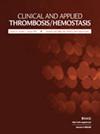Assessment of the Clinical Value of Platelet-to-Lymphocyte Ratio in Patients with Hepatocellular Carcinoma
IF 2
4区 医学
Q2 HEMATOLOGY
引用次数: 0
Abstract
Hepatocellular carcinoma (HCC) is associated with higher mortality as a result of poor prognosis and unavailability of effective treatment options. This study retrospectively analyzed the clinical value of platelet-to-lymphocyte ratio (PLR) to aid in differentiating early hepatocellular carcinoma from liver cirrhosis patients. Three hundred and nine (309) patients including 155 patients with hepatocellular carcinoma (HCC) and 154 patients with liver cirrhosis were enrolled in this study. General clinical characteristics and blood parameters of each patient were collected, calculated, and retrospectively analyzed. Mann–Whitney U test was calculated to compare the two groups. Receiver operating characteristics (ROC) curve was performed to investigate the diagnostic potential of PLR in the prediction of HCC at a cut-off with high accuracy (area under the curve [AUC]) > 0.80. Hemoglobin (HB) concentration, red blood cell (RBC) count, neutrophil (NEU) count, platelet count, platelet-to-lymphocyte ratio (PLR), and neutrophil-to-lymphocyte ratio (NLR) were significantly higher in the HCC patients than in the liver cirrhosis patients (p < 0.05). ROC curve analysis showed that the AUC, optimal cut-off value, sensitivity, and specificity of PLR to predict HCC patients were 0.912, 98.7, 81.2%, and 80.6% respectively. The results suggest that PLR is a potential biomarker that can be used to predict early HCC.评估肝细胞癌患者血小板淋巴细胞比值的临床价值
肝细胞癌(HCC)由于预后不良和缺乏有效的治疗方案,死亡率较高。本研究回顾性分析了血小板淋巴细胞比值(PLR)的临床价值,以帮助区分早期肝细胞癌和肝硬化患者。本研究共招募了 39 (309) 名患者,其中包括 155 名肝细胞癌 (HCC) 患者和 154 名肝硬化患者。研究人员收集、计算并回顾性分析了每位患者的一般临床特征和血液参数。两组患者的比较采用曼-惠特尼 U 检验。研究人员绘制了接收者操作特征曲线(ROC),以研究 PLR 在预测 HCC 时的诊断潜力,该曲线的准确性较高(曲线下面积 [AUC] 为 0.80)。HCC患者的血红蛋白(HB)浓度、红细胞(RBC)计数、中性粒细胞(NEU)计数、血小板计数、血小板与淋巴细胞比值(PLR)和中性粒细胞与淋巴细胞比值(NLR)均显著高于肝硬化患者(P <0.05)。ROC曲线分析显示,PLR预测HCC患者的AUC、最佳临界值、灵敏度和特异性分别为0.912、98.7、81.2%和80.6%。结果表明,PLR 是一种可用于预测早期 HCC 的潜在生物标志物。
本文章由计算机程序翻译,如有差异,请以英文原文为准。
求助全文
约1分钟内获得全文
求助全文
来源期刊
CiteScore
4.40
自引率
3.40%
发文量
150
审稿时长
2 months
期刊介绍:
CATH is a peer-reviewed bi-monthly journal that addresses the practical clinical and laboratory issues involved in managing bleeding and clotting disorders, especially those related to thrombosis, hemostasis, and vascular disorders. CATH covers clinical trials, studies on etiology, pathophysiology, diagnosis and treatment of thrombohemorrhagic disorders.

 求助内容:
求助内容: 应助结果提醒方式:
应助结果提醒方式:


